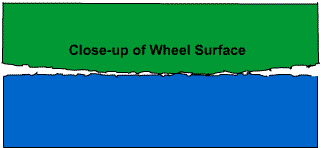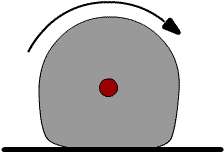|
Rolling friction is the resistive force
that slows down the motion of a rolling ball or wheel.
This frictional force is typically a combination of
several friction forces and is at the point of contact
with the ground or other surface. When the materials are
both hard, static friction and molecular friction slow
down the rolling. When the wheel or tire is soft, its
distortion slows down the motion. When the other surface
is soft, the plowing effect is a major force in slowing
the motion. The coefficient of rollng friction is
determined experimentally.
Questions you may have are:
-
How does friction slow a hard wheel
on a hard surface?
-
What happens if the wheel or surface
is soft?
-
How is the coefficient of rolling
friction determined?
Hard wheel and hard surface
When a wheel made of a hard material
rolls on a hard surface, the friction slowing down the
wheel consists of a combination of static/kinetic
friction and molecular friction.
The surface of the wheel and what it is
rolling on are not perfectly smooth. They have
irregularities.

Close-up showing surface roughness
In sliding friction, this surface
roughness is the reason for the static and kinetic
resistance to motion. Although the wheel is not sliding,
the surface roughness causes a "jiggle" when the wheel
is rolling. The resistance from this movement is close
to the point where static friction transitions to
kinetic friction.
If the wheel or tire has treads or
grooves with sharp edges, those edges add to the static
friction when they come into contact with the ground or
other surface. Treads can help to prevent spinning the
tire when the force from the torque becomes larger than
the static friction. They also help prevent skids when
braking.
Molecular friction is caused by the
molecular attraction or adhesion of the materials. It is
like a "stickiness" factor. When materials are pushed
together, molecular forces try to prevent them from
being pulled apart. This can be seen in highly polished
metals and certain materials such as rubber.
As an extreme example, you could put
double-sided tape on the rim of a wheel and see the
resistance to rolling from the sticky tape.
Soft wheel or surface
If the wheel is soft, it will deform as
it rolls, adding a component to the rolling friction. If
the ground or other surface is soft, the wheel will be
slowed by a plowing type of friction. Either can greatly
add to the rolling friction.
When a wheel or tire is relatively soft
and can be easily deformed, the resulting friction is a
form of plowing friction.

Soft tire deforms while rolling
The deformation of the tire takes up
energy that would be used to roll the wheel. Deformation
is the greatest factor in rolling friction of tires or
wheels made of soft materials.
Increasing tire pressure is a way to
reduce rolling friction in an automobile or bicycle.
When the ground or other surface is
relatively soft, the major source of friction comes from
the plowing effect. The wheel sinks into the soft
material and must push or plow its way through. Although
rolling is more effective than sliding an object in a
soft material, it still requires a substantial effort.
Trying to ride a bicycle through soft
dirt is an example of the effect of rolling friction on
a soft surface.
Although treads on the wheel or tire
will help to move the tire through the soft material,
they do not contribute much rolling friction force in
resisting the motion.
Interestingly, you can drive a vehicle
through soft dirt easier if its tires have less air. The
deformation of the tire improves traction.
Coefficient of rolling friction
Rolling friction is not as
straightforward as sliding friction. But still, there is
a relationship between the rolling friciton and the
normal force, similar to that in sliding friction. Often
the coefficient of rolling friction is determined by
assuming a form of the Standard Friction Equation holds:
FR = μR*W
where
-
FR is the resistive force of rolling
friction,
-
μR is the coefficient of rolling
friction for the two surfaces (Greek letter "mu" sub
R), and
-
W is the weight of the wheel (in the
case of a wheel rolling on the ground surface).
The coefficient of rolling friction, μR,
isn't a simple number as in the case of sliding friction
for hard materials. Instead, it is proportional to the
width of the wheel and inversely proportional to the
radius. In the case of soft wheels and tires, μR the
surface area of the tire on the ground is a factor.
A way that μR is determined is by
rolling a wheel at an initial velocity, v, and then
measuring the time, t, that it takes to stop.
μR = v/(t*g)
where g is the acceleration of gravity
9.8 m/s2 or 32 ft/s2.
This method and equation can be used
with hard or soft wheels. Although it does not require
the weight or size of the wheel to be known, it only
applies for a wheel similar to that being measured.
When the brakes are applied to a moving
vehicle such that they are locked, the rolling friction
changes to kinetic sliding friction. The chart below
compares the rolling and kinetic coefficient of friction
for various wheels.
|
Coefficient of Friction |
| Train wheel on
steel track |
0.001 |
0.1 |
| Ordinary car
tire on dry pavement |
0.015 |
0.8 |
| Truck tire on
dry pavement |
0.006-0.01 |
0.8 |
The hard train wheel has a lower rolling
friction, but it does not brake as well. The softer car
and truck tires have a much larger rolling friction, but
they will stop the vehicle better.
Rolling friction is the force that slows
down the motion of a rolling wheel. This frictional
force is typically a combination of several friction
forces at the point of contact with the ground. When the
materials are both hard, static friction and molecular
friction slow down the rolling. When the wheel or tire
is soft, its distortion slows down the motion. When the
other surface is soft, the plowing effect is a major
force in slowing the motion. |